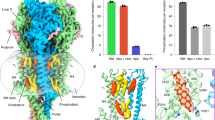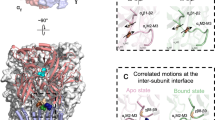Abstract
THE method of electrophoretic ejection from multibarrel micropipettes, in conjunction with the recording of electrical responses from single neurones1, provides a unique opportunity for classifying central acetylcholine receptors according to their pharmacological properties. It has been usual to subdivide these receptors into nicotinic and muscarinic types, a classification based on the original use of these terms by Dale2 to describe the peripheral actions of certain derivatives of choline. The following evidence has suggested that the receptors of Betz cells are muscarinic3: nicotine is a weak excitant; acetyl-β-methylcholine and dl-muscarine are almost as active as acetylcholine; the excitation by acetylcholine is slow in onset and is readily blocked by atropine but not by dihydro-β-erythroidine. In contrast the acetylcholine receptors of Renshaw cells exhibit nicotinic properties4: nicotine is a more powerful excitant than acetylcholine; acetyl-β-methylcholine and dl-muscarine are very weak; the excitation by acetylcholine is rapid in action and is readily blocked by dihydro-β-erythroidine but not by atropine. The acetylcholine sensitivities of ventrobasal thalamic neurones, and of cerebellar neurones, are of intermediate types5.
This is a preview of subscription content, access via your institution
Access options
Subscribe to this journal
Receive 51 print issues and online access
$199.00 per year
only $3.90 per issue
Buy this article
- Purchase on Springer Link
- Instant access to full article PDF
Prices may be subject to local taxes which are calculated during checkout
Similar content being viewed by others
References
Curtis, D. R., in Physical Techniques in Biological Research, edit. by Nastuk, W. L., 5 (Academic Press, New York, 1964). Salmoiraghi, G. C., and Bloom, F. E., Science, 144, 493 (1964).
Dale, H. H., J. Pharmacol., 6, 147 (1914).
Krnjević, K., and Phillis, J. W., J. Physiol., 166, 328 (1963). Crawford, J. M., and Curtis, D. R. (unpublished observations).
Eccles, J. C., Fatt, P., and Koketsu, K., J. Physiol., 126, 524 (1954). Eccles, J. C., Eccles, R. M., and Fatt, P., J. Physiol., 131, 154 (1956). Curtis, D. R., and Eccles, R. M., J. Physiol., 141, 446 (1958). Curtis, D. R., and Ryall, R. W. (unpublished observations).
Andersen, P., and Curtis, D. R., Acta physiol. Scand. (in the press). Crawford, J. M., Curtis, D. R., Voorhoeve, P. E., and Wilson, V. S., Nature, 200, 579 (1963).
Frank, K., and Fuortes, M. G. F., J. Physiol., 131, 424 (1956).
Ambache, N., Perry, W. L. M., and Robertson, P. A., Brit. J. Pharmacol., 11, 442 (1956). Eccles, R. M., and Libet, B., J. Physiol., 157, 484 (1961). Takeshige, C., and Volle, R. L., J. Pharmacol., 138, 66 (1962). Eccles, J. C., The Physiology of Synapses (Springer-Verlag, Berlin, 1964).
Author information
Authors and Affiliations
Rights and permissions
About this article
Cite this article
CURTIS, D., RYALL, R. Nicotinic and Muscarinic Receptors of Renshaw Cells. Nature 203, 652–653 (1964). https://doi.org/10.1038/203652a0
Issue Date:
DOI: https://doi.org/10.1038/203652a0
This article is cited by
-
Spinal cholinergic interneurons differentially control motoneuron excitability and alter the locomotor network operational range
Scientific Reports (2018)
-
Über die Wirkung von Atropin auf die Entladungsfrequenz in Phrenicus-Einzelfasern der Ratte
Archives of Toxicology (1973)
-
Some aspects of the pharmacology of autonomic ganglion cells
Ergebnisse der Physiologie Biologischen Chemie und Experimentellen Pharmakologie (1967)
Comments
By submitting a comment you agree to abide by our Terms and Community Guidelines. If you find something abusive or that does not comply with our terms or guidelines please flag it as inappropriate.



